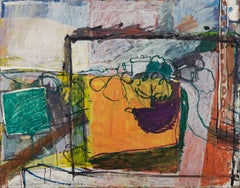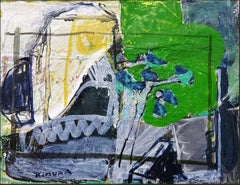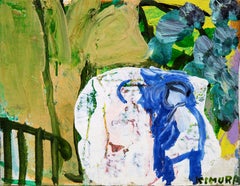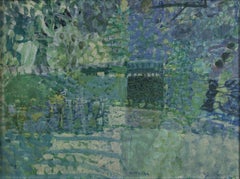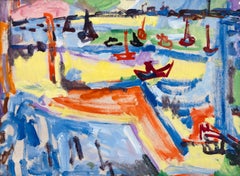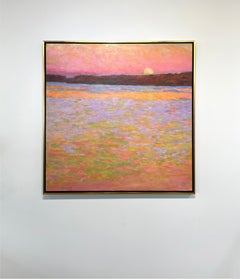Kimura Chuta
Japanese, 1917-1987
Chuta KIMURA (also "Tchuta" or "Tshuta") is an allusive landscape painter and pastellist. His name - composed of the words Ki (tree) and Mura (village) - literally means "village tree". The artist was born into a middle-class family with an ancestral Samurai background. From the age of 13, he took drawing lessons at the Takamatsu School of Decorative Arts. In 1936, he went on to study at Tokyo's Nika Art Academy, where the academic teaching did not suit him. In 1937, he exhibited for the first time at the Dokuritsu Salon, but was immediately drafted by the army to serve in China - where, despite the war, he developed a passion for ancient calligraphy. Shortly afterwards, in 1941, he discovered a painting by Pierre Bonnard at the Ohara Art Museum in Kurashiki, the light of which overwhelmed him.
In 1947, he married Satchiko Yunoki, with whom he decided to move to Paris. Thanks to a patron, the young couple settled in Montparnasse in March 1953 (taking over the former studio of his illustrious compatriot, Foujita). In 1954, he exhibited at the Salon des Artistes Français and met Jacques Zeitoun, artistic director of the "Art Vivant" gallery (Paris and Lyon), who immediately signed him up.
From 1955 onwards, Kimura enjoyed a steady stream of solo exhibitions - in Paris (e.g. Galerie St Placide, Kriegel, or Art Yomiuri - the latter exhibiting his work 4 times at FIAC in the 1980s); Lyon (e.g. Galerie St Georges); Antibes (e.g. Galerie St Georges); and Paris. galerie St Georges); Antibes (ex. galerie René Raporte); Brussels (ex. galerie de France et du Benelux); Geneva (ex. galerie Krugier); Tokyo (ex. galleries Nichido, or Takarashi); and New York (ex. galleries David Findlay, or Ruth Sigel). The artist also participated in fairs and group exhibitions (e.g. Biennale de Paris in 1957, Centre Pompidou in 1979, The Phillips Collection in 1985). In 1962, he moved to Châtenay-Malabry and met Jean Grenier - professor of philosophy and holder of the chair of aesthetics and art science at the Sorbonne - who became his principal biographer: "When Kimura rightly prides himself on uniting East and West, which, he writes, are as different from each other as day and night are from each other, he might add that it is by remaining himself and drawing on the dual traditions of his country that he has succeeded in creating a work that is at once so violent and so gentle." In 1963, the French State bought a painting from him - "Jardin à Châtenay". In 1965, Galerie Kriegel took him on under contract until 1977. In 1987, the artist attended his last exhibition in New York.
Kimura's works can be found in the permanent collections of numerous institutions and corporations: MAM Paris; Fonds National d'Art Contemporain; The Phillips Collection, Washington D.C.; MOMAT; National MoA, Osaka; MoA - Hiroshima, Kamiya, and Takasaki; Setayaga Art Museum; MoMA - Saitama, Ibaraki, and Gunma; Takamatsu City MoA; Toyota Motor Corporation; Abu Dhabi Oil Co. and Nippon Television Network Corporation.(Biography provided by Atari Arts)
to
1
15
15
12
6
6
3
1
1
Pegomas by Kimura Chuta, Abstract Impressionism, New School of Paris
Located in PARIS, FR
Chuta KIMURA (also "Tchuta" or "Tshuta") is an allusive landscape painter and pastellist. His name - composed of the words Ki (tree) and Mura (village) -...
Category
1980s Abstract Kimura Chuta
Materials
Oil
Les maisons by Kimura Chuta, Abstract Impressionism, New School of Paris
Located in PARIS, FR
Chuta KIMURA (also "Tchuta" or "Tshuta") is an allusive landscape painter and pastellist. His name - composed of the words Ki (tree) and Mura (village) -...
Category
1970s Abstract Kimura Chuta
Materials
Oil
Deux villageois by Kimura Chuta, Abstract Impressionism, New School of Paris
Located in PARIS, FR
Chuta KIMURA (also "Tchuta" or "Tshuta") is an allusive landscape painter and pastellist. His name - composed of the words Ki (tree) and Mura (village) -...
Category
1970s Abstract Kimura Chuta
Materials
Oil
Sans titre by Kimura Chuta, Abstract Impressionism, New School of Paris
Located in PARIS, FR
Chuta KIMURA (also "Tchuta" or "Tshuta") is an allusive landscape painter and pastellist. His name - composed of the words Ki (tree) and Mura (village) -...
Category
1980s Abstract Kimura Chuta
Materials
Oil
Parc de Saint-Cloud
Located in PARIS, FR
Chuta KIMURA (also "Tchuta" or "Tshuta") is an allusive landscape painter and pastellist. His name - composed of the words Ki (tree) and Mura (village) - ...
Category
Mid-20th Century Impressionist Kimura Chuta
Materials
Oil
Grasse by Kimura Chuta, Abstract Impressionism, New School of Paris
Located in PARIS, FR
Chuta KIMURA (also "Tchuta" or "Tshuta") is an allusive landscape painter and pastellist. His name - composed of the words Ki (tree) and Mura (village) -...
Category
1970s Kimura Chuta
Materials
Oil
Place du village by Kimura Chuta, Abstract Impressionism, New School of Paris
Located in PARIS, FR
Chuta KIMURA (also "Tchuta" or "Tshuta") is an allusive landscape painter and pastellist. His name - composed of the words Ki (tree) and Mura (village) -...
Category
1970s Abstract Kimura Chuta
Materials
Oil
Paysage by Kimura Chuta, Abstract Impressionism, New School of Paris
Located in PARIS, FR
Chuta KIMURA (also "Tchuta" or "Tshuta") is an allusive landscape painter and pastellist. His name - composed of the words Ki (tree) and Mura (village) -...
Category
1980s Abstract Kimura Chuta
Materials
Oil
Road by Kimura Chuta, Abstract Impressionism, New School of Paris
Located in PARIS, FR
Chuta KIMURA (also "Tchuta" or "Tshuta") is an allusive landscape painter and pastellist. His name - composed of the words Ki (tree) and Mura (village) -...
Category
1980s Abstract Kimura Chuta
Materials
Oil
Sans titre by Kimura Chuta, Abstract Impressionism, New School of Paris
Located in PARIS, FR
Chuta KIMURA (also "Tchuta" or "Tshuta") is an allusive landscape painter and pastellist. His name - composed of the words Ki (tree) and Mura (village) -...
Category
1980s Kimura Chuta
Materials
Oil
Reveil Matin (Alarm Clock) by Kimura Chuta, Impressionism, New School of Paris
Located in PARIS, FR
Chuta KIMURA (also "Tchuta" or "Tshuta") is an allusive landscape painter and pastellist. His name - composed of the words Ki (tree) and Mura (village) - literally means "village tree". The artist was born into a middle-class family with an ancestral Samurai background. From the age of 13, he took drawing lessons at the Takamatsu School of Decorative Arts. In 1936, he went on to study at Tokyo's Nika Art Academy, where the academic teaching did not suit him. In 1937, he exhibited for the 1st time at the Dokuritsu Salon, but was immediately drafted by the army to serve in China - where, despite the war, he developed a passion for ancient calligraphy. In 1940, he eventually returned to Japan due to illness. Shortly afterwards, in 1941, he discovered a painting by Pierre Bonnard at the Ohara Art Museum in Kurashiki, the light of which overwhelmed him. He was mobilized again in China in 1945, then, once the war was over, he resumed his exhibitions in Tokyo and discovered Bonnard once again. In 1947, he married Satchiko Yunoki, with whom he decided to move to Paris. Thanks to a patron, the young couple settled in Montparnasse in March 1953 (taking over the former studio of his illustrious compatriot, Foujita). In 1954, he exhibited at the Salon des Artistes Français and met Jacques Zeitoun, artistic director of the "Art Vivant" gallery (Paris and Lyon), who immediately signed him up.
From 1955 onwards, Kimura enjoyed a steady stream of solo exhibitions - in Paris (e.g. Galerie St Placide, Kriegel, or Art Yomiuri - the latter exhibiting his work 4 times at FIAC in the 1980s); Lyon (e.g. Galerie St Georges); Antibes (e.g. Galerie St Georges); and Paris. galerie St Georges); Antibes (ex. galerie René Raporte); Brussels (ex. galerie de France et du Benelux); Geneva (ex. galerie Krugier); Tokyo (ex. galleries Nichido, or Takarashi); and New York (ex. galleries David Findlay, or Ruth Sigel). The artist also participated in fairs and group exhibitions (e.g. Biennale de Paris in 1957, Centre Pompidou in 1979, The Phillips Collection in 1985). In 1962, he moved to Châtenay-Malabry and met Jean Grenier - professor of philosophy and holder of the chair of aesthetics and art science at the Sorbonne - who became his principal biographer: "When Kimura rightly prides himself on uniting East and West, which, he writes, are as different from each other as day and night are from each other, he might add that it is by remaining himself and drawing on the dual traditions of his country that he has succeeded in creating a work that is at once so violent and so gentle. In 1963, the French State bought a painting from him - "Jardin à Châtenay". In 1965, Galerie Kriegel (recently opened by his 1st dealer...
Category
1950s Impressionist Kimura Chuta
Materials
Oil
Landscape by Kimura Chuta Abstract Impressionism News School of Paris
Located in PARIS, FR
Chuta KIMURA (also "Tchuta" or "Tshuta") is an allusive landscape painter and pastellist. His name - composed of the words Ki (tree) and Mura (village) - literally means "village tree". The artist was born into a middle-class family with an ancestral Samurai background. From the age of 13, he took drawing lessons at the Takamatsu School of Decorative Arts. In 1936, he went on to study at Tokyo's Nika Art Academy, where the academic teaching did not suit him. In 1937, he exhibited for the 1st time at the Dokuritsu Salon, but was immediately drafted by the army to serve in China - where, despite the war, he developed a passion for ancient calligraphy. In 1940, he eventually returned to Japan due to illness. Shortly afterwards, in 1941, he discovered a painting by Pierre Bonnard at the Ohara Art Museum in Kurashiki, the light of which overwhelmed him. He was mobilized again in China in 1945, then, once the war was over, he resumed his exhibitions in Tokyo and discovered Bonnard once again. In 1947, he married Satchiko Yunoki, with whom he decided to move to Paris. Thanks to a patron, the young couple settled in Montparnasse in March 1953 (taking over the former studio of his illustrious compatriot, Foujita). In 1954, he exhibited at the Salon des Artistes Français and met Jacques Zeitoun, artistic director of the "Art Vivant" gallery (Paris and Lyon), who immediately signed him up.
From 1955 onwards, Kimura enjoyed a steady stream of solo exhibitions - in Paris (e.g. Galerie St Placide, Kriegel, or Art Yomiuri - the latter exhibiting his work 4 times at FIAC in the 1980s); Lyon (e.g. Galerie St Georges); Antibes (e.g. Galerie St Georges); and Paris. galerie St Georges); Antibes (ex. galerie René Raporte); Brussels (ex. galerie de France et du Benelux); Geneva (ex. galerie Krugier); Tokyo (ex. galleries Nichido, or Takarashi); and New York (ex. galleries David Findlay, or Ruth Sigel). The artist also participated in fairs and group exhibitions (e.g. Biennale de Paris in 1957, Centre Pompidou in 1979, The Phillips Collection in 1985). In 1962, he moved to Châtenay-Malabry and met Jean Grenier - professor of philosophy and holder of the chair of aesthetics and art science at the Sorbonne - who became his principal biographer: "When Kimura rightly prides himself on uniting East and West, which, he writes, are as different from each other as day and night are from each other, he might add that it is by remaining himself and drawing on the dual traditions of his country that he has succeeded in creating a work that is at once so violent and so gentle. In 1963, the French State bought a painting from him - "Jardin à Châtenay". In 1965, Galerie Kriegel (recently opened by his 1st dealer...
Category
1970s Kimura Chuta
Materials
Oil
Landscape by Kimura Chuta, Abstract Impressionism, New School of Paris
Located in PARIS, FR
Chuta KIMURA (also "Tchuta" or "Tshuta") is an allusive landscape painter and pastellist. His name - composed of the words Ki (tree) and Mura (village) - literally means "village tree". The artist was born into a middle-class family with an ancestral Samurai background. From the age of 13, he took drawing lessons at the Takamatsu School of Decorative Arts. In 1936, he went on to study at Tokyo's Nika Art Academy, where the academic teaching did not suit him. In 1937, he exhibited for the 1st time at the Dokuritsu Salon, but was immediately drafted by the army to serve in China - where, despite the war, he developed a passion for ancient calligraphy. In 1940, he eventually returned to Japan due to illness. Shortly afterwards, in 1941, he discovered a painting by Pierre Bonnard at the Ohara Art Museum in Kurashiki, the light of which overwhelmed him. He was mobilized again in China in 1945, then, once the war was over, he resumed his exhibitions in Tokyo and discovered Bonnard once again. In 1947, he married Satchiko Yunoki, with whom he decided to move to Paris. Thanks to a patron, the young couple settled in Montparnasse in March 1953 (taking over the former studio of his illustrious compatriot, Foujita). In 1954, he exhibited at the Salon des Artistes Français and met Jacques Zeitoun, artistic director of the "Art Vivant" gallery (Paris and Lyon), who immediately signed him up.
From 1955 onwards, Kimura enjoyed a steady stream of solo exhibitions - in Paris (e.g. Galerie St Placide, Kriegel, or Art Yomiuri - the latter exhibiting his work 4 times at FIAC in the 1980s); Lyon (e.g. Galerie St Georges); Antibes (e.g. Galerie St Georges); and Paris. galerie St Georges); Antibes (ex. galerie René Raporte); Brussels (ex. galerie de France et du Benelux); Geneva (ex. galerie Krugier); Tokyo (ex. galleries Nichido, or Takarashi); and New York (ex. galleries David Findlay, or Ruth Sigel). The artist also participated in fairs and group exhibitions (e.g. Biennale de Paris in 1957, Centre Pompidou in 1979, The Phillips Collection in 1985). In 1962, he moved to Châtenay-Malabry and met Jean Grenier - professor of philosophy and holder of the chair of aesthetics and art science at the Sorbonne - who became his principal biographer: "When Kimura rightly prides himself on uniting East and West, which, he writes, are as different from each other as day and night are from each other, he might add that it is by remaining himself and drawing on the dual traditions of his country that he has succeeded in creating a work that is at once so violent and so gentle. In 1963, the French State bought a painting from him - "Jardin à Châtenay". In 1965, Galerie Kriegel (recently opened by his 1st dealer...
Category
1970s Abstract Kimura Chuta
Materials
Oil
View of the Seine River in Corbeil by Kimura Chuta from the New School of Paris
Located in PARIS, FR
Chuta KIMURA (also "Tchuta" or "Tshuta") is an allusive landscape painter and pastellist. His name - composed of the words Ki (tree) and Mura (village) - literally means "village tree". The artist was born into a middle-class family with an ancestral Samurai background. From the age of 13, he took drawing lessons at the Takamatsu School of Decorative Arts. In 1936, he went on to study at Tokyo's Nika Art Academy, where the academic teaching did not suit him. In 1937, he exhibited for the 1st time at the Dokuritsu Salon, but was immediately drafted by the army to serve in China - where, despite the war, he developed a passion for ancient calligraphy. In 1940, he eventually returned to Japan due to illness. Shortly afterwards, in 1941, he discovered a painting by Pierre Bonnard at the Ohara Art Museum in Kurashiki, the light of which overwhelmed him. He was mobilized again in China in 1945, then, once the war was over, he resumed his exhibitions in Tokyo and discovered Bonnard once again. In 1947, he married Satchiko Yunoki, with whom he decided to move to Paris. Thanks to a patron, the young couple settled in Montparnasse in March 1953 (taking over the former studio of his illustrious compatriot, Foujita). In 1954, he exhibited at the Salon des Artistes Français and met Jacques Zeitoun, artistic director of the "Art Vivant" gallery (Paris and Lyon), who immediately signed him up.
From 1955 onwards, Kimura enjoyed a steady stream of solo exhibitions - in Paris (e.g. Galerie St Placide, Kriegel, or Art Yomiuri - the latter exhibiting his work 4 times at FIAC in the 1980s); Lyon (e.g. Galerie St Georges); Antibes (e.g. Galerie St Georges); and Paris. galerie St Georges); Antibes (ex. galerie René Raporte); Brussels (ex. galerie de France et du Benelux); Geneva (ex. galerie Krugier); Tokyo (ex. galleries Nichido, or Takarashi); and New York (ex. galleries David Findlay, or Ruth Sigel). The artist also participated in fairs and group exhibitions (e.g. Biennale de Paris in 1957, Centre Pompidou in 1979, The Phillips Collection in 1985). In 1962, he moved to Châtenay-Malabry and met Jean Grenier - professor of philosophy and holder of the chair of aesthetics and art science at the Sorbonne - who became his principal biographer: "When Kimura rightly prides himself on uniting East and West, which, he writes, are as different from each other as day and night are from each other, he might add that it is by remaining himself and drawing on the dual traditions of his country that he has succeeded in creating a work that is at once so violent and so gentle. In 1963, the French State bought a painting from him - "Jardin à Châtenay". In 1965, Galerie Kriegel (recently opened by his 1st dealer...
Category
1960s Abstract Kimura Chuta
Materials
Oil
Green Field by Kimura Chuta, Abstract Impressionism, New School of Paris
Located in PARIS, FR
Chuta KIMURA (also "Tchuta" or "Tshuta") is an allusive landscape painter and pastellist. His name - composed of the words Ki (tree) and Mura (village) - literally means "village tree". The artist was born into a middle-class family with an ancestral Samurai background. From the age of 13, he took drawing lessons at the Takamatsu School of Decorative Arts. In 1936, he went on to study at Tokyo's Nika Art Academy, where the academic teaching did not suit him. In 1937, he exhibited for the 1st time at the Dokuritsu Salon, but was immediately drafted by the army to serve in China - where, despite the war, he developed a passion for ancient calligraphy. In 1940, he eventually returned to Japan due to illness. Shortly afterwards, in 1941, he discovered a painting by Pierre Bonnard at the Ohara Art Museum in Kurashiki, the light of which overwhelmed him. He was mobilized again in China in 1945, then, once the war was over, he resumed his exhibitions in Tokyo and discovered Bonnard once again. In 1947, he married Satchiko Yunoki, with whom he decided to move to Paris. Thanks to a patron, the young couple settled in Montparnasse in March 1953 (taking over the former studio of his illustrious compatriot, Foujita). In 1954, he exhibited at the Salon des Artistes Français and met Jacques Zeitoun, artistic director of the "Art Vivant" gallery (Paris and Lyon), who immediately signed him up.
From 1955 onwards, Kimura enjoyed a steady stream of solo exhibitions - in Paris (e.g. Galerie St Placide, Kriegel, or Art Yomiuri - the latter exhibiting his work 4 times at FIAC in the 1980s); Lyon (e.g. Galerie St Georges); Antibes (e.g. Galerie St Georges); and Paris. galerie St Georges); Antibes (ex. galerie René Raporte); Brussels (ex. galerie de France et du Benelux); Geneva (ex. galerie Krugier); Tokyo (ex. galleries Nichido, or Takarashi); and New York (ex. galleries David Findlay, or Ruth Sigel). The artist also participated in fairs and group exhibitions (e.g. Biennale de Paris in 1957, Centre Pompidou in 1979, The Phillips Collection in 1985). In 1962, he moved to Châtenay-Malabry and met Jean Grenier - professor of philosophy and holder of the chair of aesthetics and art science at the Sorbonne - who became his principal biographer: "When Kimura rightly prides himself on uniting East and West, which, he writes, are as different from each other as day and night are from each other, he might add that it is by remaining himself and drawing on the dual traditions of his country that he has succeeded in creating a work that is at once so violent and so gentle. In 1963, the French State bought a painting from him - "Jardin à Châtenay". In 1965, Galerie Kriegel (recently opened by his 1st dealer...
Category
1980s Kimura Chuta
Materials
Oil
Related Items
Untitled (View of Provincetown Harbor)
By Hans Hofmann
Located in Palm Desert, CA
"Untitled (View of Provincetown Harbor)", is an oil on panel work made by Hans Hofmann circa 1937. The work is stamped verso by the estate of Hans Hofmann. The artwork size is 17 1/4...
Category
Early 20th Century Abstract Expressionist Kimura Chuta
Materials
Oil, Panel
"Tangerine Evening II, " Abstract Landscape Oil Painting
By Ken Elliott
Located in Westport, CT
This abstract landscape oil painting by Ken Elliott features a warm, vibrant palette and captures a landscape with the sun just along the horizon. The painting has an impressionistic...
Category
2010s Abstract Impressionist Kimura Chuta
Materials
Canvas, Oil
"Haze in the Forest, " Abstract Landscape Painting
By Ken Elliott
Located in Westport, CT
This contemporary abstract landscape painting by Ken Elliott is made with oil paint on canvas. It features a cool violet-blue palette, capturing an abstracted scene of a forest in th...
Category
2010s American Impressionist Kimura Chuta
Materials
Canvas, Oil
Spirit Of The Downs, Original Atmospheric Landscape Painting, Affordable Art
By Richard Whadcock
Located in Deddington, GB
Spirit Of The Downs by Richard Whadcock [2021]
The South Downs never cease to give inspiration for new work. The light, drama and atmosphere changes from da...
Category
2010s Impressionist Kimura Chuta
Materials
Canvas, Oil
H 29.53 in W 29.53 in D 2.17 in
Cloudveil
Located in Kennett Square, PA
CLOUD VEIL
By SPENCER VERNEY
36”x36”
Oil on stretched canvas
2019
Category
2010s Impressionist Kimura Chuta
Materials
Canvas, Oil
Sunset Coming, Abstract Seascape, Original Landscape Painting, Framed Artwork
Located in Deddington, GB
Stormy Skies is an original landscape painting by Stephen Kinder. The painting has a strong gestural composition and loose brushwork, which heightens the changing light, and tide.
A...
Category
2010s Abstract Impressionist Kimura Chuta
Materials
Oil, Board
H 16.54 in W 14.97 in D 0.99 in
Antique American Modernist Summer Beach Scene Framed Hamptons Ocean Oil Painting
Located in Buffalo, NY
Very impressive mid 20th century beach scene. Great colors. Nice vintage frame. Oil on board. No signature found. Image size, 12H x16L.
Category
1960s Modern Kimura Chuta
Materials
Canvas, Oil
H 17 in W 21 in D 2 in
20th Century French Cubist Oil Painting Street View at Night Time
Located in Cirencester, Gloucestershire
Artist/ School: French 20th Century artist
Title: Cubist street scene at dusk
Medium: oil painting on canvas, unframed.
canvas: 25.5 x 21.25 inches
Provenance: private collectio...
Category
20th Century Cubist Kimura Chuta
Materials
Oil, Canvas
Antique American School Modernist Abstract Landscape Framed Original Painting
Located in Buffalo, NY
Vintage mid century abstract landscape. Oil on board. Framed. Possible illegible signature to lower left.
Category
1940s Abstract Kimura Chuta
Materials
Canvas, Oil
eclat printanier, abstract lanscape, oil, expressionism, multicolor, french
By SOPHIE DUMONT
Located in LANGRUNE-SUR-MER, FR
Sophie Dumont, with her work entitled "eclat printanier" offers us a captivating vision of a countryside reinterpreted through her unique artistic prism.
Chhose your frame black or n...
Category
21st Century and Contemporary Abstract Expressionist Kimura Chuta
Materials
Oil
H 15.75 in W 15.75 in D 0.79 in
"Ghost of the Gardens" (green, floral, vibrant, energetic, abstract landscapes)
By Nicholas Evans
Located in Paris, IDF
"Ghosts of the Gardens" is a mysterious and captivating abstract painting, evoking the untamed beauty of wild gardens and chaotic floral motifs with its energetic and loose movement....
Category
21st Century and Contemporary Abstract Kimura Chuta
Materials
Canvas, Oil Crayon, Oil Pastel, Oil, Acrylic
H 23.63 in W 19.69 in D 0.71 in
"PaperLandscape" Abstract Original Art, Minimal Painting made in Italy
By Marilina Marchica
Located in Agrigento, AG
PaperLandscape
is a series of artworks inspired by landscape and nature,
nature and the passage change over time, we change nature and nature changes man
the connection between man ...
Category
2010s Abstract Kimura Chuta
Materials
Enamel
No Reserve
H 39.38 in W 31.5 in D 1.19 in
Kimura Chuta art for sale on 1stDibs.
Find a wide variety of authentic Kimura Chuta art available for sale on 1stDibs. If you’re browsing the collection of art to introduce a pop of color in a neutral corner of your living room or bedroom, you can find work that includes elements of blue and other colors. You can also browse by medium to find art by Kimura Chuta in oil paint, paint and more. Much of the original work by this artist or collective was created during the 20th century and is mostly associated with the abstract style. Not every interior allows for large Kimura Chuta art, so small editions measuring 8 inches across are available. Kimura Chuta art prices can differ depending upon medium, time period and other attributes. On 1stDibs, the price for these items starts at $6,062 and tops out at $88,180, while the average work can sell for $19,840.
